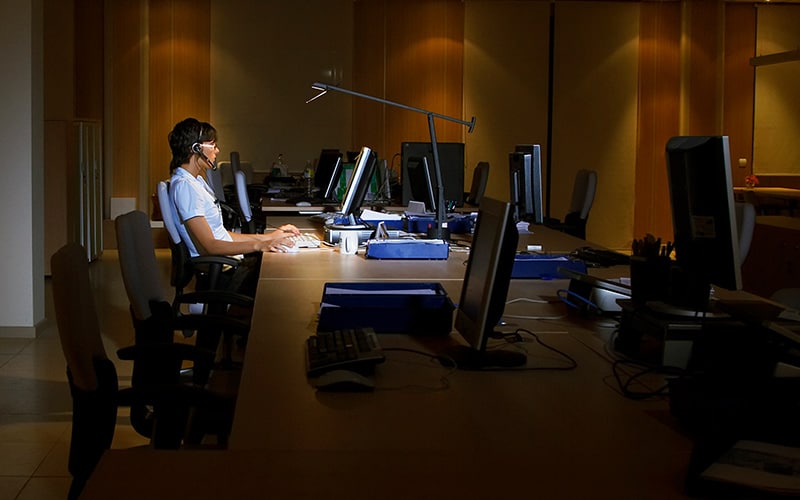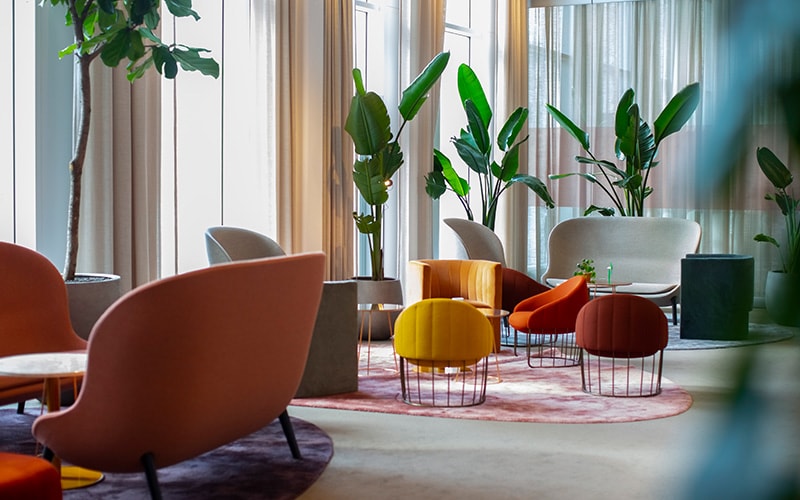Insights
- Loneliness has been termed a serious global threat by the WHO.
- A large percentage of employees globally are experiencing loneliness and disconnectedness, which can affect their productivity and their companies’ profitability.
- This has been spurred by collaboration overload, lack of genuine connection, and a sedentary lifestyle.
- Organizations need to examine their workplace situations, and leverage technology and people practices to find the solution, to support their employees.

Loneliness has been on the rise - so much so that the World Health Organization (WHO) has declared it a global health threat. Loneliness is also an issue for businesses. While technology is helping employees connect seamlessly, authentic and meaningful connections are lacking, leading to workplace loneliness. Research shows that 62% of US workers may be considered lonely, while a study of British professionals shows that over half of the respondents felt lonely at the workplace which they attributed to not having anything in common with colleagues. Lonely workers feel less productive, and each lonely worker could be costing their organization close to $4,200 annually in additional work days lost. Loneliness has been linked to stress-related absenteeism – work days missed due to feeling stressed – that is avoidable.
Workplace loneliness refers to the feelings of isolation or disconnection that can arise from factors ranging from a lack of communication and trust between colleagues and not feeling supported by peers, to not being able to identify with the work one is doing. Imperative’s 2022 Workforce Purpose Index shows that 57% of their respondents felt that managers are not building strong relationships with their people.
Loneliness has been linked to stress-related absenteeism – work days missed due to feeling stressed – that is avoidable.
Other causes for disconnection
Work trends that have emerged in recent times could also be the reason for disconnection:
- After the pandemic, corporations globally have adopted a hybrid working model and been encouraging employees to spend time in the office as well as work remotely. But many continue to allow remote working. This mixed routine has led to employees working in silos and feeling disconnected from the organization due to lack of collaboration and interaction across the wider organization.
- On the flip side, the last few years have been marked by an increase in collaboration at the workplace. Studies show that while pre pandemic, employees spent 85% of their time on calls and email, now, time spent on collaborative activities had increased by 50% over the past decade. It has seen an increase since the pandemic, with employees working approximately five to eight hours more a week, starting work earlier in the day and working later into the night. This has led to collaboration overload. Virtualization of the workplace can overburden employees, as shown in Infosys’s The Future of Work 2023 report. Collaborative platforms have made employees easily accessible to others, and given rise to a culture of urgency. It creates a feeling of pressure to always be available to respond to work requests. Ironically, overexposure to these tools and being constantly connected have led employees to limit interactions with colleagues to the most necessary tasks, rarely having the energy or attention to give to meaningful interactions, causing feelings of loneliness.
Collaborative platforms have made employees easily accessible to others, and given rise to a culture of urgency.
- While remote work has been a boon for employees owing to the convenience it lends to their lives, it has led to a sedentary lifestyle characterized by sitting at a desk for long hours, which can in turn make workers feel lonely.

Connections are good for business
Feeling disconnected and isolated from the organization and colleagues can affect the cognitive abilities of individuals and their ability to deal with challenging situations. Disconnected employees do not collaborate effectively in tasks that involve teamwork, which can impact not only their job performance but also the quality of work produced by the team.
On the other hand, employees who feel a sense of connectedness can help the bottom line. A Gallup study shows that having a best friend at work is not only tied to employee satisfaction but also to business outcomes such as profitability and retention. It helps employees engage clients and internal partners better, and finish more work in less time, and creates a culture where team members deal with workplace changes together and support each other’s successes.
From silos to synergy
Organizations can increase connectedness between employees using a carefully managed combination of technology, workplace design, and organizational practices.
- Organizational success will depend upon using tools in new ways to bridge the gap between employee purpose and productivity. A deep dive into data around collaboration platforms at the workplace – purpose of usage, duration, and the effectiveness – can help identify redundancies and reduce time spent by employees on the platforms or instances of being included in meetings or emails unnecessarily, thus preventing a collaboration overload. Companies such as Uber and General Mills closely monitor organizational data to prevent collaboration overload for employees and take measures to mitigate related issues, helping employees work more productively. It is equally important to make employees aware of the existence of collaboration overload as an issue so they can also make efforts to prevent it.
Organizational success will depend upon using tools in new ways to bridge the gap between employee purpose and productivity.

-
Modern technologies can be used to reduce isolation and improve connectedness. Using a common platform for employees prevents information dissemination done in silos, and employees from feeling left out. For instance, Kerzner International built a mobile-first employee app for their workforce to come together, receive organizational updates, and participate in knowledge-sharing regardless of where people are working from.
WongDoody has been harnessing InfyMe – Infosys’s award-winning intranet framework – to deliver a unified shared service experience for organizations and their employees. The InfyMe accelerator framework provides employees with a single interface containing all the tools and support required for them to thrive in the workplace, fostering a sense of connection with their employer as well as more efficiently managing any HR, IT, or finance related tasks. WongDoody’s human-centred design approach has also helped increase employee productivity and efficiency for a leading global design and construction brand, where 90% of the employees felt more in the loop with updates following the launch of their new intranet platform.
WongDoody has been harnessing InfyMe – Infosys’s award-winning intranet framework – to deliver a unified shared service experience for organizations and their employees.
In another case, a leading Nordic postal and logistics company was losing new delivery recruits faster than it could hire them, with significant impact on operating costs, hiring costs, and delivery quality. WongDoody’s research showed that it was owing to new recruits finding the training too short and superficial to cover the complexity and nuance of the job. It meant workers were feeling isolated and as if they were failing, and so they were leaving. A mobile app was developed to give the employees easy access to information and advice from peers. This improved connectedness and led to a significant reduction in attrition, and an increase in delivery quality and overall employee satisfaction.
David Stocks, head of strategy for EMEA at WongDoody, recognizes the impact disconnection is having on employees and businesses. “The pandemic and the rise of hybrid work models have undeniably amplified a sense of employee disconnect. While surveys and dedicated tools are helpful, many businesses still struggle to grasp the human element – the needs and challenges employees face during those pivotal, personal moments that truly matter. This disconnect is a significant driver of turnover, decreased productivity, absenteeism, and ultimately, a decline in work quality costing organizations millions annually.
By embracing human-centred experience design, we can bridge this gap. We need to design digital experiences that not only enhance productivity but also foster a sense of connection and belonging, no matter where employees work from.”
-
Human-centric office design can be an effective means to foster employee connection especially when spaces aren’t focused only on function and also care about aesthetics, helping encourage socializing as well as working. This means striking a balance between spaces that allow individuals to brainstorm with teams, or work or participate in video calls individually, and spaces such as break rooms and lounges that encourage friendly catch-ups that can help counter feelings of isolation and disconnectedness.
Human-centric office design can be an effective means to foster employee connection.

L’Oreal’s headquarters in Paris, where some 2,500 people work, has been designed to be functional and warm, as opposed to a steely office setting. The Bosch AS office – an old factory in Schwäbisch Gmünd, Germany, converted to a modern office – intentionally scatters individual and group workstations to promote interactions between employees. The lack of room divisions can help reduce isolation.
- With work friendships playing an important role in dispelling loneliness and increasing connectedness, it’s important for leaders to champion the cause of friendships at work, and the importance of building connections across the business.
- Four-day working weeks have been proven to have benefits including reduced stress and tiredness and increased happiness as seen in individuals who were part of global city-wide pilot programs. They seemed to be accomplishing more work in less time, and were able to use the extra day for personal activities. It might be a practice for companies to consider, to support employee wellbeing.
- Companies should remind employees of the importance of mental health, physical health, and the need to lead an active lifestyle – whether they are remote workers or not – to promote wellness. Organizing sessions by health experts or team sport events, or providing subsidies to gym memberships are recommended to help employees take better care of themselves.
With an average person estimated to spend one third of their life at work, employers have a responsibility to help individuals build connections with colleagues – not just because it helps boost physical and mental health, but also because it brings benefits to the entire business.






